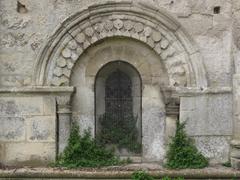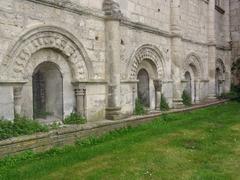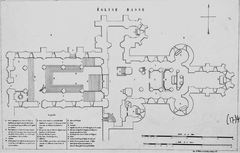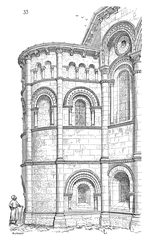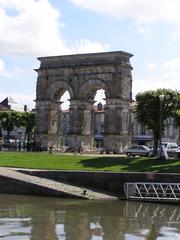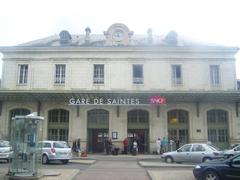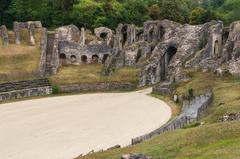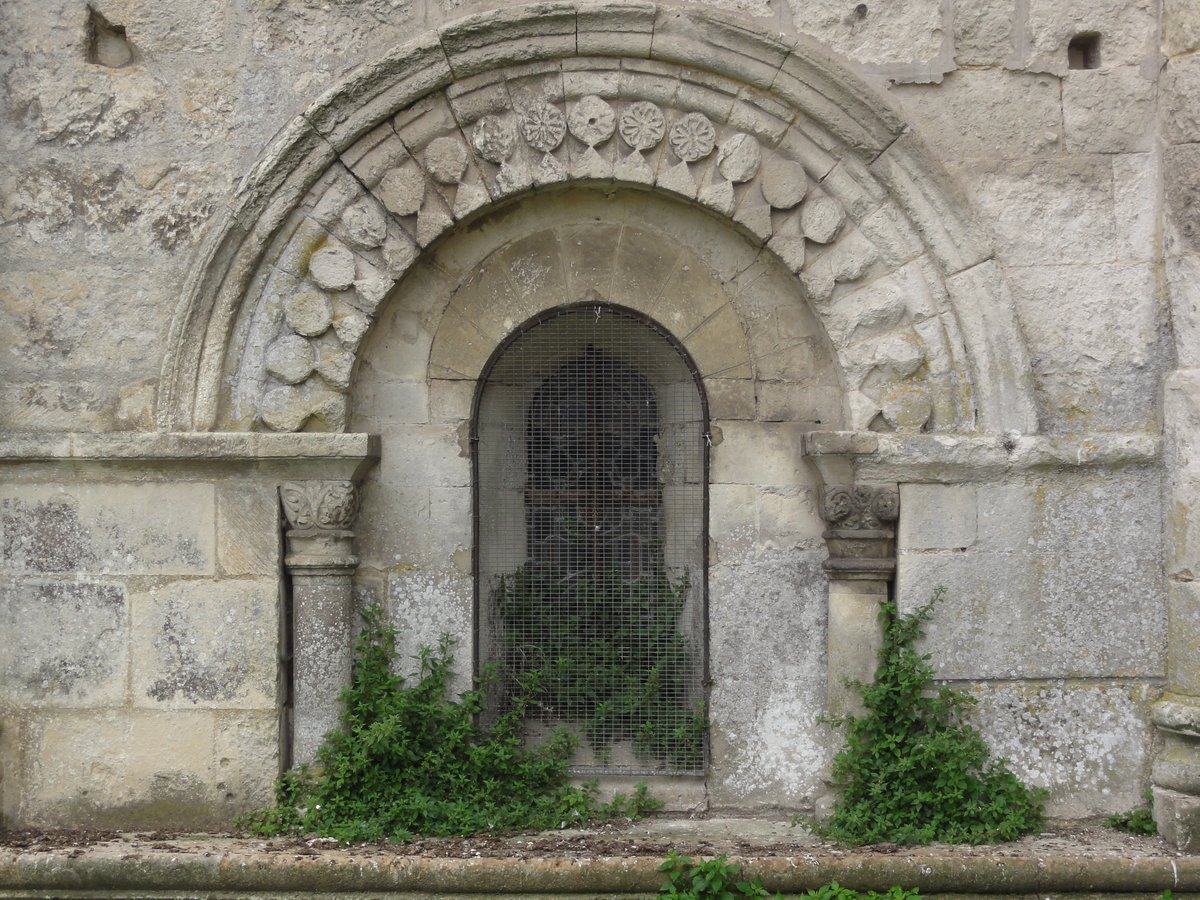
Visiting Hours, Tickets, and Historical Sites: Basilique Saint-Eutrope, Saintes, France
Publication Date: 20/07/2024
Introduction
The Basilique Saint-Eutrope in Saintes, France, stands as a testament to the rich historical, architectural, and religious heritage of the region. Constructed in the 11th century, this basilica was initially part of a larger abbey complex dedicated to Saint Eutropius, the first bishop of Saintes. Known for its Romanesque architecture, the basilica features semi-circular arches, thick walls, and a crypt that is one of the largest of its kind in Europe. The crypt houses the relics of Saint Eutropius, making it a significant pilgrimage site on the medieval Way of Saint James (Saintes Tourism, Romanesque Architecture). Over the centuries, the basilica has undergone various expansions and restorations, including the addition of Gothic elements in the 12th century and significant renovations in the 19th century (Gothic Architecture, French Revolution). Today, it is recognized as a UNESCO World Heritage site, part of the Routes of Santiago de Compostela in France, highlighting its global cultural and historical significance (UNESCO). Whether you are a history enthusiast, an architecture aficionado, or a spiritual seeker, a visit to the Basilique Saint-Eutrope offers a unique and enriching experience. This comprehensive guide provides essential information on visiting hours, ticket prices, travel tips, and nearby attractions to help you plan your visit effectively.
Table of Contents
- [Discover the Rich History and Visiting Information of Basilique Saint-Eutrope in Saintes](#discover-the-rich-history-and-visiting-information-of-basilique-saint-eutrope-in-saintesdiscover-the-rich-history-and-visiting-information-of-basilique-saint-eutrope-in-saintes)
- [Origins and Early History](#origins-and-early-historyorigins-and-early-history)
- [Architectural Development](#architectural-developmentarchitectural-development)
- [Expansion and Modifications](#expansion-and-modificationsexpansion-and-modifications)
- [The Role of Pilgrimage](#the-role-of-pilgrimagethe-role-of-pilgrimage)
- [Decline and Restoration](#decline-and-restorationdecline-and-restoration)
- [Modern Significance](#modern-significancemodern-significance)
- [Notable Features](#notable-featuresnotable-features)
- [The Crypt](#the-cryptthe-crypt)
- [The Upper Church](#the-upper-churchthe-upper-church)
- [The Bell Tower](#the-bell-towerthe-bell-tower)
- [Visiting Hours](#visiting-hoursvisiting-hours)
- [Ticket Prices](#ticket-pricesticket-prices)
- [Travel Tips](#travel-tipstravel-tips)
- [Nearby Attractions](#nearby-attractionsnearby-attractions)
- [Accessibility](#accessibilityaccessibility)
- [Preservation Efforts](#preservation-effortspreservation-efforts)
- [Cultural Impact](#cultural-impactcultural-impact)
- [FAQ](#faqfaq)
- [Conclusion](#conclusionconclusion)
- [References and Further Reading](#references-and-further-readingreferences-and-further-reading)
Discover the Rich History and Visiting Information of Basilique Saint-Eutrope in Saintes
Origins and Early History
The Basilique Saint-Eutrope, located in Saintes, France, is a significant historical and religious monument. Its origins date back to the 11th century when it was constructed as part of the Abbey of Saint-Eutrope. The basilica was named after Saint Eutropius, the first bishop of Saintes, who is believed to have been martyred in the 3rd century. The abbey was established to honor his memory and to serve as a pilgrimage site (Saintes Tourism).
Architectural Development
The construction of the basilica began around 1081 under the direction of the Benedictine monks. The initial structure was built in the Romanesque style, characterized by its semi-circular arches and robust appearance. The lower church, or crypt, was completed first and served as the resting place for Saint Eutropius’ relics. This crypt is one of the largest and most well-preserved examples of Romanesque architecture in France (Romanesque Architecture).
Expansion and Modifications
In the 12th century, the upper church was constructed, featuring a more elaborate design with Gothic influences. This period saw the addition of a nave, transept, and choir, enhancing the basilica’s grandeur. The upper church was designed to accommodate the increasing number of pilgrims visiting the site. The basilica’s bell tower, a prominent feature, was also added during this time, providing a visual landmark for the town of Saintes (Gothic Architecture).
The Role of Pilgrimage
The Basilique Saint-Eutrope played a crucial role in the medieval pilgrimage routes, particularly the Way of Saint James (Camino de Santiago). Pilgrims traveling to Santiago de Compostela in Spain would stop at the basilica to venerate the relics of Saint Eutropius. This influx of pilgrims contributed to the economic and cultural development of Saintes, making the basilica an essential stop on the pilgrimage route (Camino de Santiago).
Decline and Restoration
The basilica experienced periods of decline, particularly during the Wars of Religion in the 16th century when it suffered significant damage. The abbey was dissolved during the French Revolution, and the basilica was repurposed for secular uses. It wasn’t until the 19th century that efforts to restore the basilica began. The crypt was rediscovered and restored, and the upper church underwent significant renovations to preserve its historical and architectural integrity (French Revolution).
Modern Significance
Today, the Basilique Saint-Eutrope is recognized as a UNESCO World Heritage site, part of the Routes of Santiago de Compostela in France. This designation highlights its historical and cultural significance, ensuring its preservation for future generations. The basilica continues to attract visitors from around the world, drawn by its rich history, architectural beauty, and spiritual significance (UNESCO).
Notable Features
The Crypt
The crypt of Basilique Saint-Eutrope is one of its most remarkable features. It houses the relics of Saint Eutropius and is renowned for its impressive Romanesque architecture. The crypt’s vaulted ceilings and intricately carved capitals are exemplary of the craftsmanship of the period. It remains a place of pilgrimage and reflection for visitors (Romanesque Crypts).
The Upper Church
The upper church, with its Gothic elements, contrasts with the Romanesque crypt below. The nave is adorned with pointed arches and ribbed vaults, typical of Gothic architecture. The stained glass windows, added during the 19th-century restoration, depict scenes from the life of Saint Eutropius and other biblical stories, adding to the basilica’s spiritual ambiance (Gothic Stained Glass).
The Bell Tower
The bell tower of Basilique Saint-Eutrope is a significant architectural feature, offering panoramic views of Saintes and the surrounding countryside. It serves as a reminder of the basilica’s historical role as a beacon for pilgrims. The tower’s design reflects the transition from Romanesque to Gothic styles, with its sturdy base and more ornate upper sections (Medieval Bell Towers).
Visiting Hours
The Basilique Saint-Eutrope is open to visitors daily. Visiting hours are typically from 9:00 AM to 6:00 PM, but it’s recommended to check the official website or local tourism office for any changes or special events that might affect these hours.
Ticket Prices
Entry to the basilica is generally free, but donations are encouraged to support ongoing preservation efforts. Special guided tours may have a fee, and it’s advisable to book these in advance.
Travel Tips
- Best Time to Visit: The basilica can be visited year-round, but the best time to experience its beauty is during the spring and autumn months when the weather is mild.
- Photography: Photography is allowed, but be respectful of the sacred nature of the site. Flash photography may be restricted in certain areas.
- Local Cuisine: Don’t miss the chance to try local Saintes cuisine at nearby restaurants.
Nearby Attractions
- Arch of Germanicus: A well-preserved Roman triumphal arch located nearby.
- Saintes Cathedral: Another stunning example of Gothic architecture.
- Abbey aux Dames: A former Benedictine abbey with rich history and beautiful grounds.
Accessibility
The Basilique Saint-Eutrope is committed to being accessible to all visitors. Wheelchair access is available, although some areas of the crypt may be challenging due to the historic nature of the building. It’s recommended to contact the site in advance for specific accessibility needs.
Preservation Efforts
Ongoing preservation efforts are crucial to maintaining the basilica’s structural integrity and historical significance. These efforts include regular maintenance, restoration of damaged elements, and archaeological research to uncover more about the basilica’s past. The involvement of local and international organizations ensures that the Basilique Saint-Eutrope remains a treasured heritage site (Heritage Preservation).
Cultural Impact
The Basilique Saint-Eutrope has had a lasting cultural impact on the town of Saintes and beyond. It has inspired numerous works of art, literature, and music, reflecting its importance in the cultural and spiritual life of the region. The basilica’s annual festivals and events continue to draw visitors, celebrating its rich history and ongoing legacy (Cultural Festivals).
FAQ
Q: What are the visiting hours for Basilique Saint-Eutrope?
A: The basilica is open daily from 9:00 AM to 6:00 PM. It’s best to check the official website for any changes.
Q: Is there an entry fee for Basilique Saint-Eutrope?
A: Entry is generally free, but donations are encouraged. Special guided tours may have a fee.
Q: Can I take photos inside the basilica?
A: Yes, photography is allowed, but please be respectful of the sacred nature of the site. Flash photography may be restricted.
Q: Is the basilica accessible for visitors with disabilities?
A: Yes, wheelchair access is available, though some areas of the crypt may be challenging. Contact the site in advance for specific needs.
Conclusion
The Basilique Saint-Eutrope in Saintes, France, is more than just a historical monument; it is a living testament to the region’s rich cultural, architectural, and religious heritage. From its Romanesque crypt, which houses the relics of Saint Eutropius, to its Gothic upper church and iconic bell tower, the basilica offers a unique glimpse into the medieval pilgrimage routes and the architectural styles of different eras. Despite periods of decline and repurposing, the basilica has been meticulously restored and preserved, ensuring that its history and beauty remain accessible to future generations. Today, it continues to attract visitors from around the world, drawn by its historical significance, architectural splendor, and spiritual ambiance. Whether you are exploring its intricate carvings, participating in a guided tour, or simply soaking in the serene atmosphere, a visit to Basilique Saint-Eutrope is a journey through time and faith. As you plan your visit, remember to check the latest information on visiting hours and special events, and consider exploring the nearby attractions to make the most of your trip (Saintes Tourism, France-Voyage).
References and Further Reading
- Discover the Rich History and Visiting Information of Basilique Saint-Eutrope in Saintes, 2024, Saintes Tourism
- Romanesque Architecture, 2024, Romanesque Architecture
- Gothic Architecture, 2024, Gothic Architecture
- French Revolution, 2024, History
- UNESCO, 2024, UNESCO
- Sacred Destinations, 2024, Sacred Destinations
- Catholic Saints, 2024, Catholic Saints
- France-Voyage, 2024, France-Voyage
- Abbaye aux Dames, 2024, Abbaye aux Dames
